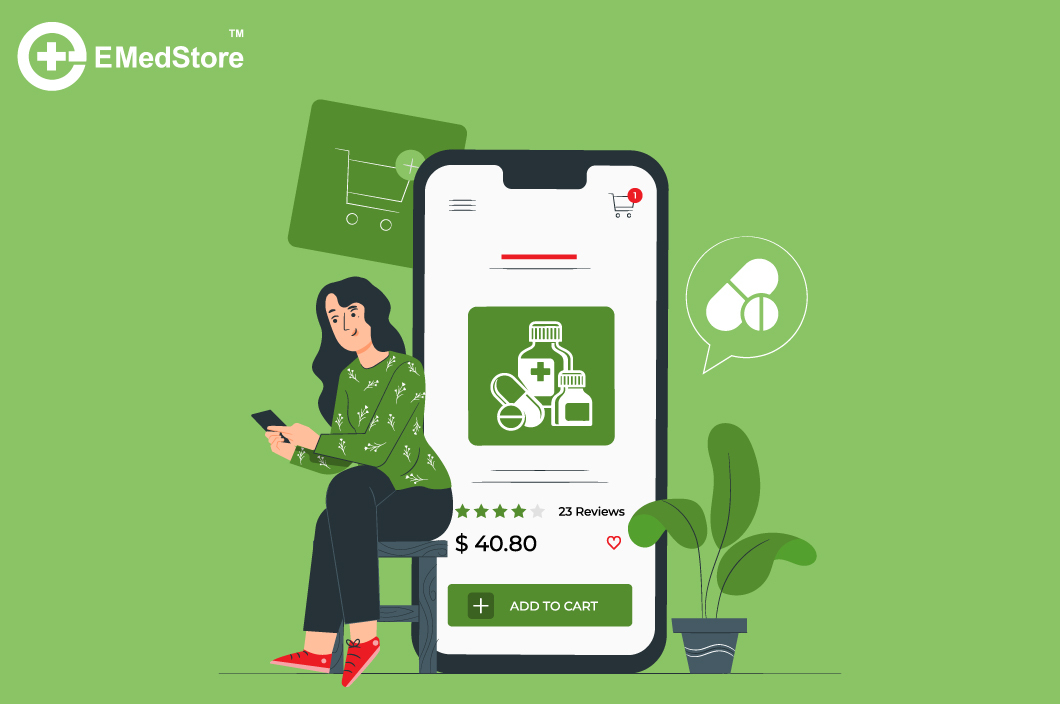It’s 2022, and the pharma industry is rapidly growing and changing as its customers’ buying habits change. The pharma industry is becoming more patient-centric, and this trend will continue due to technological advances in the field. It is becoming more global, more digital, and more competitive. And that is why most pharmacists are looking for ways by which they can compete in the market and thrive.
Medicine delivery apps, which sell medicines and medicines to customers online, are one such opportunity that has been around for quite some time but is still growing rapidly as consumers look for more convenient ways to purchase their medicines online. If you’re considering developing a medicine delivery app, then this is the only guide you’ll ever need. This guide will show you the trends in online pharmacy, the main challenges you’ll likely encounter in medicine delivery app development, and how to create your medicine delivery app.
So, without further ado, let’s dive deep into your ultimate guide to developing your medicine delivery app.
This guide touches upon the following aspects of the medicine delivery app development:
- Key benefits of medicine delivery apps for customers and companies.
- Different business models for an online pharmacy
- Essential features of ePharmacy
- How does it work
- Technological stack needed for an online pharmacy app
- How to earn money with a medicine delivery app
- How to develop your online pharmacy
Let’s learn how you can create a medicine delivery app that can transform healthcare and can turn it into a successful business.
The process of developing a medicine delivery app is not that different from creating any other on-demand app. However, there are several specific aspects you should take into account when building an app like Netmeds or 1mg. It would be best if you kept a few things in mind to create an app that meets your requirements.
If you’re wondering why I should invest in a medicine delivery app in 2022? Let us look at the market forecast for the same.
Industry overview:
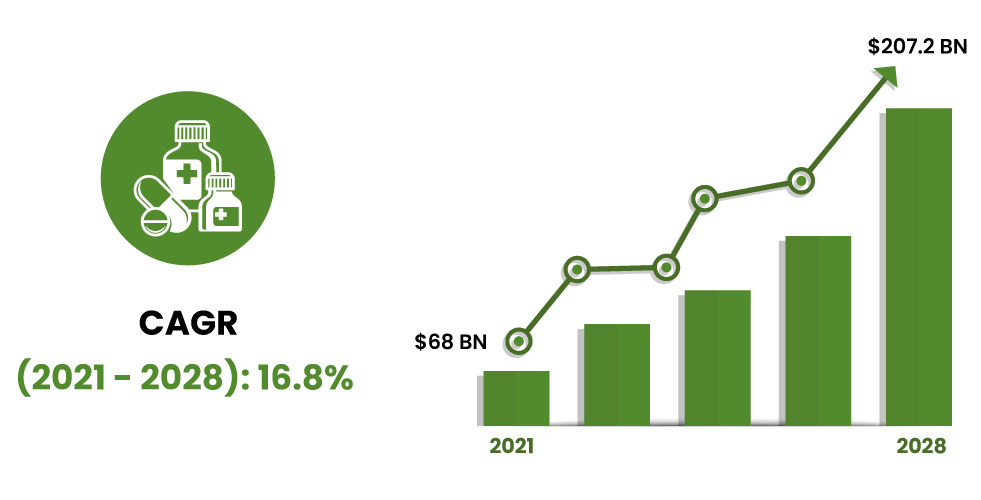
The online pharmacy market size already surpassed 68 billion USD in 2021 and is expected to reach 207.2 billion USD by 2028. It is anticipated to witness a growth of over 16.8% CAGR during that period.
The report noted that the growth of online pharmacies was boosted by the growing penetration of online pharmacy platforms across the world and an increase in the awareness regarding services offered by e-pharmacy. [GMI Research]
ePharmacy market consists of OTC products and medicine order medicine, among which the OTC products segment held over 70% market share in 2021, while medicine order medicines contributed the remaining 30%. But do you ever wonder why customers are inclined toward ePharmacies? Let us find out.
Why are customers inclined towards ePharmacies?
When it comes to the benefits customers enjoy from online pharmacies, there are many factors like ease of purchasing, quality services, availability of a range of medications, and increasing accessibility to the internet that has shifted the customer preference towards e-pharmacy platforms. Additionally, a substantial increase in smartphone users will propel the global market further as it enables ePharmacy providers to capture a broad range of customer bases across the developed and developing economies.
Now, let’s look at the benefits of medicine delivery apps by customers as well as pharmacists:
Customer benefits of Medicine Delivery App:
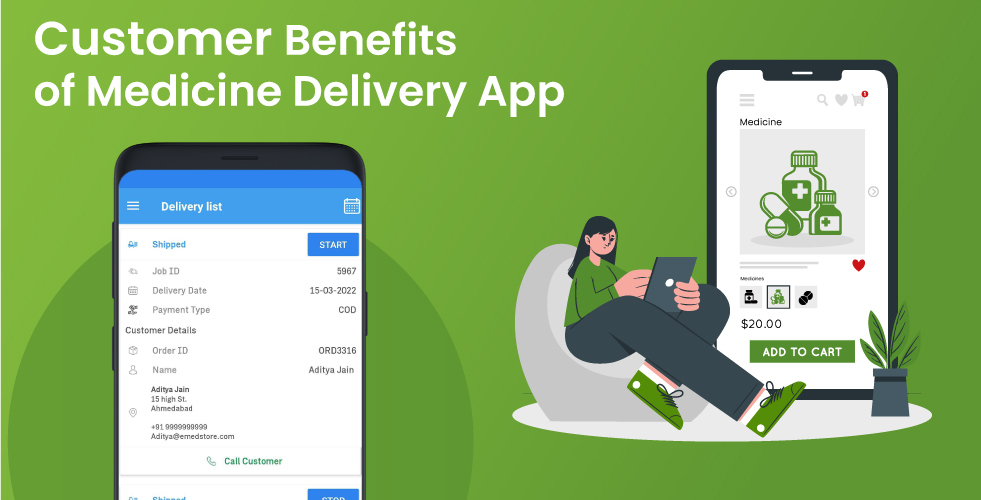
- Essential medicines at the comfort of their homes
- Wide variety of medicines
- Access to details about medicines
- No need to leave the house
- Discounts and special offers
- Ability to track orders
- Rapid price comparison
Pharmacist benefits of Medicine Delivery App: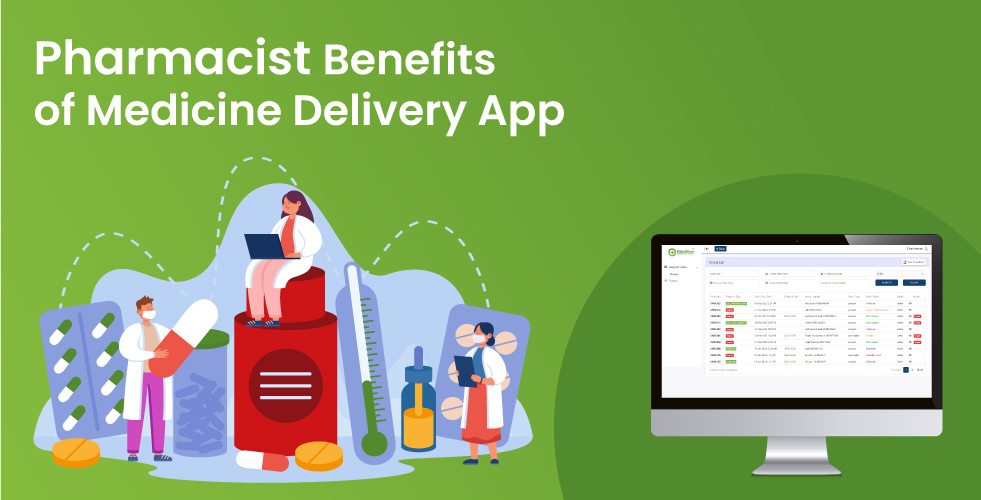
- Higher customer engagement
- Easier customer retention
- Advanced analytics
- Improved customer base
- Improved brand building
- Enhanced marketing options
- Higher revenue generation
Business Models of a Medicine Delivery App:
Now let us look at the different business models of a medicine delivery app. Fundamentally, medicine delivery apps can be of two types:
1. Operational Model of Medicine Delivery App:
In this model, a brick-and-mortar pharmacy owner creates a digital twin of its existing pharmacy store online. Retail pharmacy owners expand themselves from an offline business to an online world by creating a medicine delivery app, wherein they accept orders from their customers and deliver them from their offline store.
This business model is suitable for big pharmacies with an inventory of their own. Such companies can create a medicine delivery app for their business and venture into the lucrative online world. The USP of this type of business model is high brand recognition.
2. Marketplace Model of Medicine Delivery App:
In this model, a person develops an online pharmacy first and then ties up with a local brick-and-mortar pharmacy without stocking the medicines himself.
Whenever a customer places an order from their portal, they check the availability of the medicine from their partner local pharmacy store and proceed accordingly. If it is available, they redirect the order to the local pharmacy store near the customer’s location.
Generally, the revenue is shared between the online platform developer and the local pharmacy. The marketplace model doesn’t require huge infrastructure and doesn’t even need inventory.
Essential features of a medicine delivery app:
A medicine delivery app may need various features depending on the business model and locality’s needs. Generally, you’ll need to create four separate apps to offer a complete package, which is as follows:
Customer App of Medicine Delivery App:
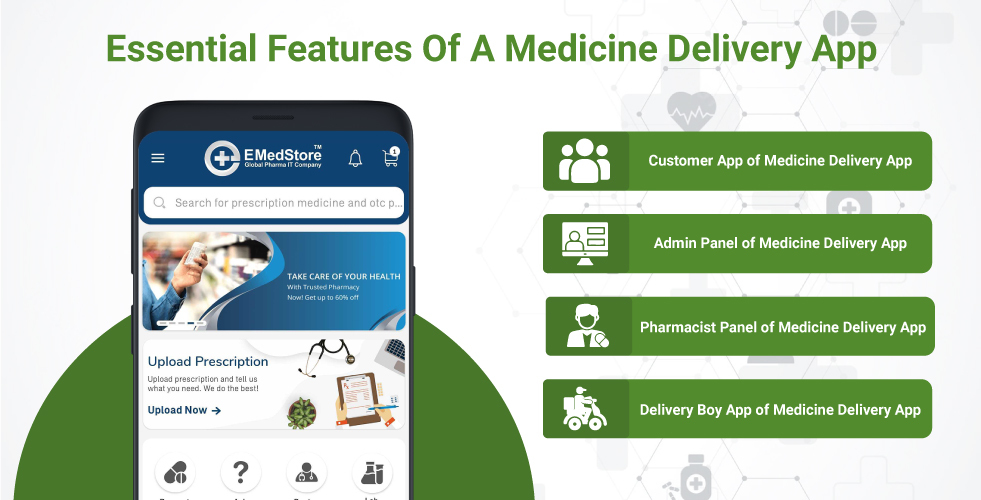
- User-friendly and easy-to-use UI: The UI of the app should be modern and minimalistic, which will boost accessibility and engagement. It is enticing to the customers and easy to use.
- Search and buy: A search and buy functionality allows medicine ordering without scrolling through the whole catalog. If you implement search through voice also, it becomes very accessible.
- Upload Medicine order: Customers should be able to click a photo of the medicine order and upload it directly. One should be able even to choose the picture from the gallery also. As simple as that.
- Dose reminder: Set dose reminders with descriptions, so your customer always takes their medicines on time. Later on, they should be able to modify their reminders also.
- Order History: Order history enables customers to view past orders and re-order. Order information should contain handy details like order ID, order date, delivery date, total amount, etc.
- Find Substitutes: This feature lists all the alternatives and cheaper options of the products based on the composition of the searched item.
Admin Panel of Medicine Delivery App:
- Abandoned Cart Report: See what your customers are putting in the cart but not purchasing, and then send them a notification and give an exciting discount on those items.
- Manage Orders: View and manage all orders in one place, assign orders to pharmacists, and track their status.
- Order return/refund: Accept partial/full returns on orders and credit refunds directly into customers’ wallets or bank accounts from where the payment has been made.
- Simple and clickable banners: Upload clickable banners on the home page to boost the click-through rate. Simple and clickable banners let customers know about your offerings easily.
- Reports and Analytics: Generate detailed analytic reports that provide insights into top-performing pharmacy shops, highest selling products, consumer spending patterns, and more.
- Create multiple sub-admins: Create multiple sub-admins with restricted access to efficiently manage various functions.
Pharmacist Panel of Medicine Delivery App:
- Order Notification: Get real-time alerts about any new orders and successful delivery of older orders via email and push notifications.
- Product catalog management: Classify products into categories like ‘Top Selling Products,’ ‘Seasonal Products,’ etc., and assign priority and provide discounts to specific products or categories.
- Live chat: Communicate with your customers in real-time directly to sort out queries quickly.
- Content Management: Compile and update the information about available medicines, side effects, etc.
- View Medicine orders: View and verify the medicine order and approve the order.
- Sales Reports: Generate daily, weekly, or monthly sales reports conveniently from a single panel.
Delivery Boy App of Medicine Delivery App:
- Instant Notification: Delivery personnel receives an instant push notification whenever a new order is available.
- Sort orders datewise: For better viewing and navigation, orders should be sorted with the date range.
- Order Acceptance: Delivery personnel can accept or decline a new order based on availability.
- Payment Details: Know whether the payment has been made or is to be collected via COD.
- Authentic Delivery: Delivery personnel captures the receiver’s signature to ensure the delivery’s authenticity.
- Customer Details: Relevant customer information is available with the order to ensure fast services.
- Most efficient Route: The delivery agent should be provided with the most optimized route of the Order address to deliver the order in the least possible time.
Now we know which features to include in the medicine delivery app. But do you know what the workflow of such an app for the customer and pharmacist end is?
Medicine Delivery App - How does it work?
Medicine Delivery App For customers:
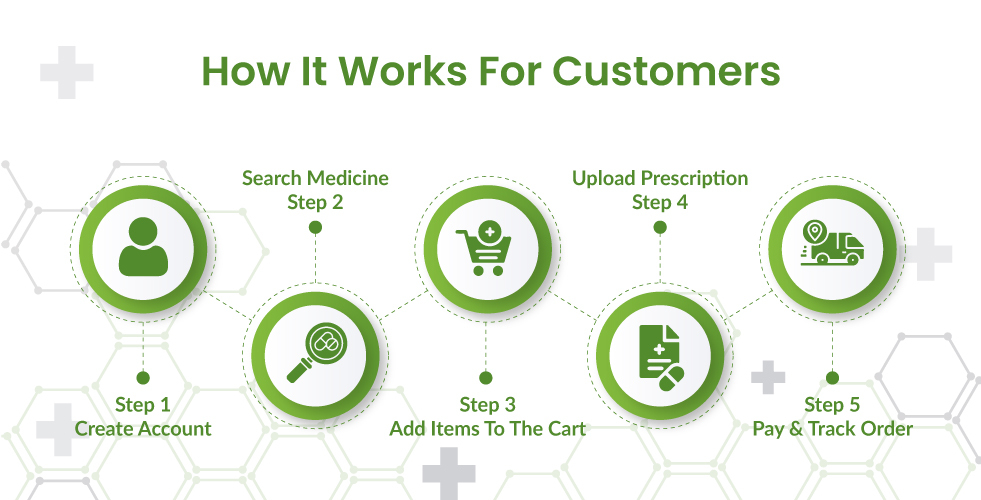
These are the steps involved in the workflow of the online pharmacy app for the customer end.
- Create account
- Search medicine
- Add items to the cart
- Upload medicine order
- Pay & Track order
Medicine Delivery App For pharmacists:
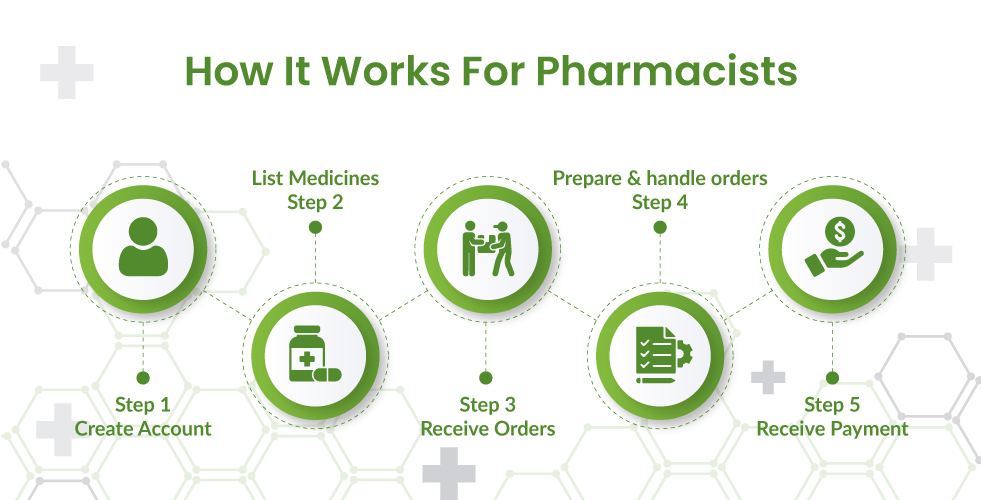
Steps for pharmacists are as shown below:
- Create account
- List medicines
- Receive orders
- Prepare & handle orders
- Receive payment
Now you know how a medicine delivery app works, but are you curious about what technology architecture enables it to execute such a workflow? Let us briefly look at that also.
Technological stack needed for a Medicine Delivery App:
The online pharmacy app comprises a complex back-end architecture. A reliable stack of technologies ensures its robustness and security. Any pharmacy delivery app needs three sections: front-end, back-end, and API integrations (Application Programming Interface).
The front-end is a client-side of an app that is visible to customers with which they interact. In contrast, the back-end is a server-side of an app that executes all the algorithms. Basically, it runs the show behind the scenes. And lastly, API is the protocol that ensures interaction between the front-end and back-end.
Look at the architecture of a robust and very solid medicine delivery app.
How to develop a medicine delivery app like NetMeds or 1mg?
So you have a great idea for an app and you’ re ready to start! Before you start coding your medicine delivery app, consider the following:
What is the target market? Is there a need for this type of service in your area? If so, who will be using it? What kind of demographic is this user base likely to fall into? Who are your competitors, and how do they compare with what you want to create? Do they offer more features or options than you’ve thought up so far (or less)? How much time can/should I dedicate to this project?
If you wish to develop your pharma delivery app, you can follow the given workflow.
Step 1: Identify target market, competitors, and monetization strategy
This is the first and foremost stage where you’ll need to identify your targeted market, modalities, common roadblocks in the sector, laws of your operating area, knowledge about competitors, etc.
Step 2: Decide the Business model.
As we discussed above, there are multiple modes of running an online pharmacy. Decide whichever is best suited for your liking and start working on it.
Step 3: Find a Medicine Delivery App Development Company
Now comes the part of actually making the app. If you know how to build the app, you can start building it. Or, you can hire a reliable medicine delivery app development company, communicate your project to them, and outsource it to them. If you wish to know how companies build such apps, we will discuss it in the last part of this guide.
Step 4: Finalize app functionality
Depending on your chosen business model, you 'll need to figure out which functionalities your app will provide to users during the launch and which functionalities will be added later. Once you have a clear idea of your app's features, you can begin to prioritize them based on their benefits and cost. This will help ensure that you do not include unnecessary or useless features in the end product.
Pro Tip: Don’t overburden your end-users by bombarding them with useless features. They’ll feel overwhelmed by it and lose interest in the app. Instead, launch your app with the necessary basic features and gradually introduce other features over time.
Step 5: Test & Launch Medicine Delivery App
Now, whether you’ve developed the app on your own or outsourced it to some ePharmacy developer, you’ll need to test the app, and if you are satisfied with it, you can launch the app for your clients.
After you’ve tested out the app and made some improvements, you’re ready to go live. The last step is to test the app again with a different group of people.
Step 6: Do proper maintenance
Don’t think that your job is over once you’ve launched your app. You need to maintain it properly and solve any bugs or issues. That is why hiring a reputed online pharmacy developer is advisable instead of doing it yourself.
Step 7: Do marketing
Now you’ve developed a very good app for your medicine delivery needs. But, what to do with it if the end-users are unaware of it?
So, do proper marketing of your app and make sure your prospective clients hear about you in a good way.
We promised we’d show you how most app development companies follow the development cycle. Let’s take a look at it:
The software development life cycle (SDLC) of our medicine delivery application is as follows:
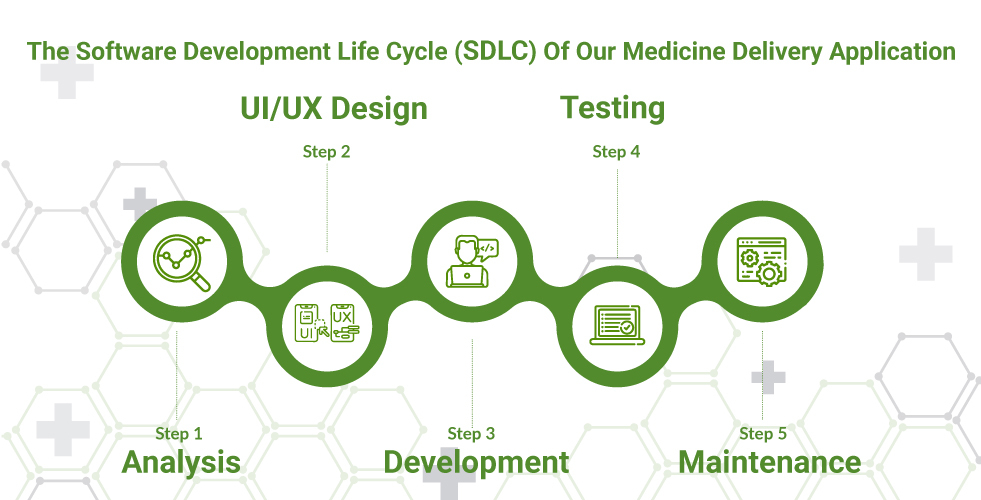
- Analysis: Our expert team will analyze user requirements and use them to prepare technical documentation
- UI/UX Design: The next stage is developing the interaction between design elements and finalizing the UI/UX of the app.
- Development: Once the app design is ready, the front-end and back-end coding are integrated to create a fully functional app.
- Testing: The app is tested to check the key areas like usability, security, interface, etc.
- Deployment: After thorough testing and re-testing, the app is deployed to the server using FTP, and subsequently final test is performed.
- Maintenance: Once the app is published, we provide maintenance and support to ensure smooth, bug-free operation.
Now let’s talk about how to make money using the app you’ve just developed:
What is the cost of developing medicine delivery apps?
The cost of developing a medicine delivery app depends on various aspects. Such as:
- Platforms: The cost of the app depends on which platform you want to go live with, like Android, iOS, or a hybrid mobile app for multiple platforms.
- Development Timeline: Depends on the time you need to complete the app.
- Features: The cost of the app usually increases with the increase in the functionalities.
- 3rd Party Integration: Integration with various 3rd party APIs will further increase the development cost.
How to earn money with a medicine delivery app?
The main goal of creating a medicine delivery app is garnering business advantage, the possibility of increasing sales, and reaching a wider audience.
There are a few ways by which you can monetize your medicine delivery app and make your business profitable.
- Fees: If you allow third-party vendors to sell products on your platform, you can make money by taking some fees for each product sold or for revenue.
- Premium Membership: You can launch a premium membership also, wherein you offer extra services in return for premium membership fees.
- Advertisements: Ads are a significant source of revenue. You can put ads on your app that promote medicine, other pharmacies, or products offered by third-party medical vendors.
Depending on your business model, you can use any of the strategies mentioned above.
As you can see, there are a lot of elements to consider when developing a medicine delivery app. To make your app truly successful, you must understand how to localize your product or content and why this is important for medicine delivery apps. The localization process is also important for medicine delivery apps because it helps meet the local market's unique needs. For example, suppose you want to develop an app that provides on-demand medical services in Delhi and London (both markets have unique requirements). In that case, you must follow this guide to learn about localization techniques and best practices that suit both markets equally well.
Conclusion:
Undoubtedly, on-demand medicine delivery apps can be a game-changer for any community. If you’re in the beginning stages of your idea, we recommend starting by identifying your target market and competitors and a monetization strategy. Then, sketch your vision for the app, from its key features to its UI/UX design. With these basics in mind, you’ll be able to develop an on-demand medicine delivery app that solves real pain points in your community—and earns revenue while doing so!
To know more about online medicine delivery apps and do you want to start your online pharmacy within 5 days at the lowest price to grow your business worldwide check this link out.
We hope we have given you insight into why creating your medicine delivery app can be a great idea. If you think we have missed something, feel free to add your thoughts.
